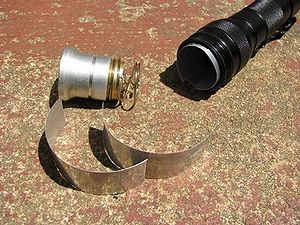P60
SureFire created an assembly called P60 that goes inside some of its flashlights. It is a 6-volt incandescent bulb and reflector assembly (for instance, the SureFire 6P, M2, and G2 flashlights all use the P60 assembly). They also make a LED version called a P60L and 9-volt versions called P90 and P90L that are the same size. This became an industry standard and now many companies offer P60 drop-ins (the bulb and reflector assembly regardless of bulb type or voltage) and P60 hosts (flashlight bodies that accept the drop-ins). Some companies avoid the SureFire naming system by calling P60 a D26 (the bezel diameter is 26.5 mm) or won't even mention P60 at all. No soldering is required: you just unscrew the head of the light, drop the assembly into the host, put the head back one, and you are ready to go.

When picking out a drop-in, make sure you match up voltage requirements. For instance if you get a 3.7-4.2V drop-in, don't operate it using two CR123A batteries which would be 6V. LED drop-ins include the reflector, an LED mounted to a board and glued or epoxied to the pill, a brass (sometimes aluminum) pill, and a 17mm driver. There is usually a small spring soldered to the bottom of the driver as a contact for the positive end of the battery and a larger spring around the pill to press the drop-in against the lens of the host and keep it from rattling around. Drop-ins are available as single mode or multi-mode, though the drivers could be swapped out separately to change that (requires soldering). CPF's LED forum has a sticky listing P60 drop-ins with a link to a list of P60 hosts. The advantage of the P60 system is that once you find a host you like, you can upgrade to a newer LED by just buying a new drop-in which will come with a reflector and driver designed for that particular LED.
Another drop-in size is D36 with a 36mm reflector. D-size Maglites with a 52mm reflector are a common host, though some modifications may be necessary (not always as simple as dropping in a module).
With a little soldering and thermal adhesive, you can build your own P60 drop-ins, using the LED and driver of your choice. See DIY P60 for a tutorial.
Heat Sinking One problem with P60 drop-ins is they do not usually allow good heat transfer from the LED and driver to the host which can cause the LED to overheat, reducing output and the life of the LED. Some people will stuff aluminum foil around the drop-in to provide a better heat path between the drop-in and the head of the light. Aluminum strips cut from a beverage can or copper strips as well as copper tape can be used. While heavy duty kitchen foil is about 1 mil (0.001 inch) thick, an aluminum beverage can is more like 4 mils thick (about 0.1 mm). Copper sheets can be purchased in varying thickness and cut to size. A typical P60 reflector is 22mm where you would wrap the light, so strips can be cut about 2.7 inches (69 mm) long, longer if it will wrap around the reflector more than once. The width of the strips will vary depending on the host, but are typically 0.5 inch to 0.75 inch. The reflector should fit very snugly if properly wrapped. Anodizing on the inside of the light will also reduce heat transfer. You could use thermal compound, but this would make it much more difficult to swap drop-ins. Even with these measures in place, it may not be advisable to use higher power LEDs (like the Cree MC-E or Luminus SST 50) in a P60 host, though there are certainly plenty of people using Cree XM-L drop-ins driven to 3 amps, which is about 10 watts of power, almost all of which is converted to heat.
Copper sheeting can be purchased at CPF Marketplace (there are also users there selling copper tape which has heat conductive adhesive), on eBay (search for "axvz" for one seller to avoid getting results of big rolls of copper), or at art supply dealer whimsie.com who have sheets in 10 and 20 mil thicknesses including 3"x3" samples that can yield 4-6 strips.